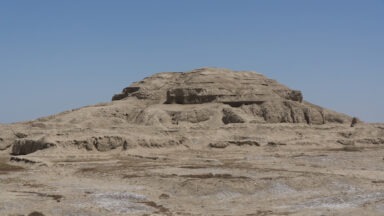Study Shows Giza Pyramid Concentrates Energy Within its Chambers

The Pyramids of Giza are an incredible engineering feat and have long been assumed to serve a greater purpose than simply being pharaonic tombs. Now, a group of physicists has discovered that the Great Pyramid can concentrate electromagnetic energy, leading scientists to believe they can use this ancient schema to create new nanoparticles for use in sensors and improved photovoltaic cells.
Using applied methods of theoretical physics, a team from ITMO University in St. Petersburg, Russia, and Laser Zentrum Hannover, a tech institute in Germany, found that the pyramids can interact with electromagnetic waves of resonant length.
Researchers used numerical modeling and analytical methods to discover that radio waves can induce resonance in the pyramid at lengths ranging from 200 to 600 meters.
Mainstream media outlets reporting on this have already written off the discovery as a coincidence of the pyramid’s structure, saying it is highly unlikely the Ancient Egyptians knew about its conductive properties.
Similar narratives claim it is racist to be skeptical that a primitive, ancient people using stone tools could build such a monolithic structure aligned within 3/60th of a degree to the Earth’s cardinal directions, and encoded with the dimensions of the planet’s equatorial circumference, polar radius, and axial precession.
The recent study found that, under resonance conditions, the pyramid can concentrate electromagnetic energy in its internal chambers and under its base. This type of energy concentration in the chambers has been proposed by proponents of alternative archeological theories.

Researchers including Graham Hancock, Robert Bauval, and Christopher Dunn have proposed the idea that the Ancient Egyptians, or a lost civilization predating them, were much more advanced than we have credited them. Dunn says he believes that the pyramids were built as an instrument to draw energy from the Earth’s ionosphere, much like Nikola Tesla’s Wardenclyffe Tower intended.
“Egyptian pyramids have always attracted great attention. We as scientists were interested in them as well, so we decided to look at the Great Pyramid as a particle dissipating radio waves resonantly,” said Dr. Sc. Andrey Evlyukhin, scientific supervisor and coordinator of the research.
“Due to the lack of information about the physical properties of the pyramid, we had to use some assumptions. For example, we assumed that there are no unknown cavities inside, and the building material with the properties of ordinary limestone is evenly distributed in and out of the pyramid. With these assumptions made, we obtained interesting results that can find important practical applications,” he said.
Teotihuacán: City of the Gods or Ancient Spaceport?

The time: The first century. The place: Teotihuacán, one of the largest Mayan cities in ancient Mexico. Its name means “City of the Gods,” or “the place where men become gods.” Despite the ancient time period, the civilization was a bustling metropolis, housing sophisticated infrastructure, engineering, and technology.
Suddenly, the residents of the great city disappeared in 7 A.D., leaving behind their once-thriving civilization. Where did they go, and why? No one is entirely sure of what happened, but a few key pieces of evidence tell us that the residents of Teotihuacán were more advanced than once thought.
Both mica and mercury — minerals that play an integral role in today’s aerospace industry — have been discovered in Teotihuacán’s ruins. Is it possible that the city’s residents departed their beloved city to establish breakaway civilizations elsewhere?
Other questions arise concerning the ruins that were left behind. The Teotihuacán pyramids turn out to be very similar to the ancient pyramids found in Egypt. How and why did that happen? The Mayans left behind mysteries that scientists, archeologists, historians, and interested people are still trying to unravel even after all these years.




































